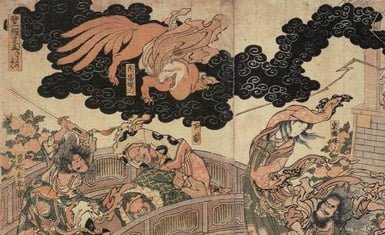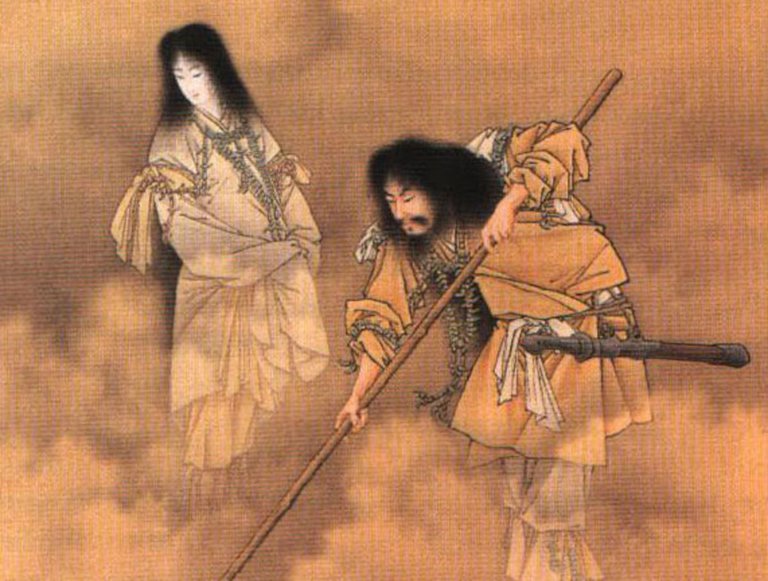What's up community? I hope you are doing very well, trying to do all the tasks of the Month Quest for this month, one of the tasks that I find the most difficult is to mention something about Japanese culture and the truth is that I haven't seen many anime that have to do with that, until I remembered that Naruto has so many references and symbolisms to Japanese myths that I find it very difficult to mention them all in a single post, so, in this post I will only mention some of them and, I hope it will be valid to accomplish the task.
¿Que tal comunidad? Espero que estén muy bien, tratando de hacer todas las tareas de el Month Quest de este mes, una de las tareas que me parecen mas difíciles es la de mencionar algo de la cultura japonesa y la verdad es que no he visto muchos animes que tengan que ver con eso, hasta que, recordé que Naruto tiene muchísimas referencias y simbolismos a mitos japoneses que se me hacen muy difíciles de mencionarlas todas en un solo post, así que, en este post solo mencionaré algunas y, espero que si sea valido para cumplir la tarea.
Kyuubi
One of the most iconic characters in Naruto is the Kyuubi (or Kurama, his real name), or at least that is in my not so humble opinion and, one of the best known stories of the Kyuubi no Kitsune is that of Tamano-no-Mae, dating back to the years 1142-1155, who was said to be the most beautiful woman in Japan and also knew all the answers to whatever was asked of her and who suddenly became ill, an astrologer discovered that the woman was actually a nine-tailed fox working for an enemy of the emperor. In Japanese culture, the fox represents a mythological creature that is able to transform itself to deceive people, its number of tails represents age, wisdom and power of the fox, as we see in the series, the more tails Naruto has, the more power he has.
Uno de los personajes mas icónicos de Naruto es el Kyuubi (o Kurama, su nombre real), o al menos eso es en mi no tan humilde opinión y, una de las historias mas conocidas del Kyuubi no Kitsune es la de Tamano-no-Mae, que data de los años 1142-1155, que se decía que era la mujer mas bella de Japón y además conocía todas las respuestas a lo que le preguntaran y que de repente enfermó, un astrólogo descubrió que la mujer en realidad era un zorro de nueve colas que trabajaba para un enemigo del emperador. En la cultura japonesa, el zorro representa a una criatura mitológica que es capaz de transformarse para engañar a las personas, su numero de colas representa edad, sabiduría y poder del zorro, tal cual como vemos en la serie, que mientras mas colas le salen a Naruto, mas poder va teniendo.
Izanagi/Izanami
The following are the two jutsus that Kishimoto pulled out of the buttocks, the Izanagi and Izanami, which, have to do with two gods of Japanese mythology that, in turn, also give rise to other gods that are jutsus in the series exclusive to the Uchiha Clan, such as Amaterasu, Susanoo and also Tsukuyomi among others.
Lo siguiente son los dos jutsus que Kishimoto se sacó de las nalgas, el Izanagi y el Izanami, que, tienen que ver con dos dioses de la mitología japonesa que, a su vez, también dan origen a otros dioses que son jutsus en la serie exclusivos del Clan Uchiha, como lo son Amaterasu, Susanoo y también Tsukuyomi entre otros.
Legendary Sannin
Orochimaru, Jiraiya and Tsunade also have a place in Japanese folklore, with a novel dating from 1839 to 1868 called "The Legend of Jiraiya the Gallant ”. Jiraiya was the scion of a powerful clan, he also learned the magic of the toads and married Tsunade who was a connoisseur of the magic of the slugs (it was already wanted the Jiraiya of the series to marry Tsunade), in the myth, one of the followers of Jiraiya learned the magic of the snakes and ended up being called Orochimaru.
Orochimaru, Jiraiya y Tsunade tambien tienen lugar en el folclor japones, con una novela que data de 1839 al 1868 llamada "La Leyenda de Jiraiya el Galante". Jiraiya era el vástago de un clan poderoso, también aprendió la magia de los sapos y se casó con Tsunade que era conocedora de la magia de las babosas (ya fuese querido el Jiraiya de la serie casarse con Tsunade), en el mito, uno de los seguidores de Jiraiya aprendió la magia de las serpientes y terminó llamándose Orochimaru.

No doubt Kishimoto implemented many references to the folklore of his country in Naruto, as these examples I mentioned, there are many more throughout the series, practically everything has to do with some Japanese myth. I hope you liked today's post, I'll say goodbye for now, thank you very much for reading and see you later in another post ❤️
Sin duda Kishimoto implementó muchísimas referencias del folclor de su país en Naruto, como estos ejemplos que mencioné, hay muchísimos mas en toda la serie, prácticamente todo tiene que ver con algún mito japones. Espero que les haya gustado mucho el post de hoy, yo por ahora me despido, muchas gracias por leerme y nos vemos luego en otro post ❤️
Sources:
Legendary Sannin
Izanagi/Izanami
Kyuubi
Item 1 Anime Posts:
Link 1 https://ecency.com/hive-158489/@ibet/haikyuu-the-dumpster-battle-is
Link 2
Item 2 Cultural Anime:
Link 1
Link 2
Link 3
Item 3 Small Events:
Link 1 https://ecency.com/hive-158489/@ibet/re-wittyzell-20241111t12530729z
Link 2
Link 3
Translated by DeepL
Traducido por DeepL




It's amazing how Kishimoto weaved so many myths and legends into the story. The connection between the Kyuubi and the fox stories is fascinating; it really reflects the richness of Japanese folklore. Awesome post!!!
if you see only the surface, it seems that it doesn't have many references, but when you investigate a little, you realize that even the names of jutsu have to do with myths and Japanese gods, it's incredible!
The japanese culture and folklore is ingrained in so many old shows....
Just like Dragon Balls Sun Goku references the monkey god Wukong
Naruto indeed has many Japanese myths and folklore references throughout the series...
Yes, I knew that Naruto had some references, but when I did some more research, I discovered that practically everything in Naruto has to do with Japanese folklore.
We can certainly see a lot of Japanese culture in Naruto, it is full of references everywhere. There are many other anime that pay tribute to Japanese folklore, I would say it is the inspiration for many mangakas.
Thanks for sharing with the community!
There are certainly a lot of anime that contain Japanese floklore, it's just a matter of keeping an eye out! It's always a pleasure to share in the community, thanks for stopping by!
¡Felicitaciones!
1. Invierte en el PROYECTO ENTROPÍA y recibe ganancias semanalmente. Entra aquí para más información.
3. Suscríbete a nuestra COMUNIDAD, apoya al trail de @Entropia y así podrás ganar recompensas de curación de forma automática. Entra aquí para más información sobre nuestro trail.
4. Creación de cuentas nuevas de Hive aquí.
5. Visita nuestro canal de Youtube.
Atentamente
El equipo de curación del PROYECTO ENTROPÍA
¡Muchas gracias!
Lol, I wanted to post almost the same post (well, at least with the same topic) for the event. It's even better that I didn't write it, because I can see from yours that I at least forgot about Jiraya. There are plenty of references to Japanese folklore and myths in this title. Good job! :)